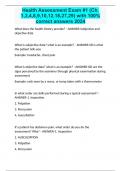Health Assessment Exam #1 (Ch.
1,3,4,8,9,10,12,18,27,29) with 100%
correct answers 2024
What does the health history provide? - ANSWER-Subjective and objective data
What is subjective data? what is an example? - ANSWER-SD is what the patient tells you
Example: headache, chest pain
What is objective data? what is an example? - ANSWER-OD are the signs perceived by the examiner through physical examination during
assessment
Example: rash seen by a nurse, or temp taken with a thermometer
In what order are skills performed during a typical assessment? - ANSWER-1. Inspection
2. Palpation 3. Percussion
4. Auscultation
If a patient has abdomen pain, what order do you do the assessment? Why? - ANSWER-1. Inspection
2. AUSCULTATION
3. Palpation
4. Percussion Health Assessment Exam #1 (Ch.
1,3,4,8,9,10,12,18,27,29) with 100%
correct answers 2024
Because of pain, don't touch or tap the tender area first. Start by inspecting and then listening before you feel the area.
What occurs during inspection, the first step? - ANSWER--ALWAYS COMES FIRST
-begins when you first meet a person w/ a general survey
-you should start assessment of each body system with inspection
-requires: good lighting, adequate exposure, use of instruments including otoscope, opthalmoscope, penlight, or specula
What occurs during palpation, the second step? - ANSWER-Palpation applies sense of touch to assess
Can include:
temperature, texture, moisture, organ location and size, swelling, vibration or pulsation, rigidity or spasticity, crepitation, presence of lumps or masses, presence of tenderness or pain
-use fingers unless taking temperature
How can you assess factors during the palpation step? - ANSWER-by using different parts of the hands Health Assessment Exam #1 (Ch.
1,3,4,8,9,10,12,18,27,29) with 100%
correct answers 2024
During palpation, what should fingertips be used to feel? - ANSWER--
best for fine tactile discrimination of skin texture, swelling, pulsation, and determining presence of lumps
During palpation, what should fingers and thumb be used for? - ANSWER--detection of position, shape, and consistency of an organ or mass
During palpation, what should the dorsa of hands and fingers be used
for? - ANSWER--best for determining temperature because skin here is thinner than on palms
During palpation, what should the base of fingers or the ulnar surface
of hand be used for? - ANSWER--best for vibration
**-vibrations are felt on the ulnar side of hand
During palpation, what type of palpation should you start with and why? What steps are next? - ANSWER-1. start with LIGHT palpation to detect surface characteristics and accustom person to being touched -1 cm
2. then deeper palpations when needed
-intermittent pressure better than one long continuous palpation
-5 to 8 cm or 2-3 in Health Assessment Exam #1 (Ch.
1,3,4,8,9,10,12,18,27,29) with 100%
correct answers 2024
ALSO: bimanual palpation- requires use of both hands to envelop or capture certain body parts or organs such as kidneys, uterus or adnexa for precise delimitation
What occurs during percussion, the third step? - ANSWER--consists of
tapping a person's skin with short, sharp strokes to assess underlying structures
What uses does percussion have? - ANSWER--mapping location and size of organs
-signaling density of a structure by a characteristic note
-detecting a superficial abnormal mass 1. percussion vibrations penetrate about 5 cm deep 2. deeper mass would give no change in percussion
-eliciting pain if underlying structure is inflamed
-eliciting deep tendon reflex using percussion hammer
HOLLOW (AIR-FILLED) ORGANS SOUND DIFFERENT THAN SOLID ORGANS - ANSWER-
What are the two methods of percussion? - ANSWER-1. Direct, or immediate, which is when the striking hand directly contacts body wall




